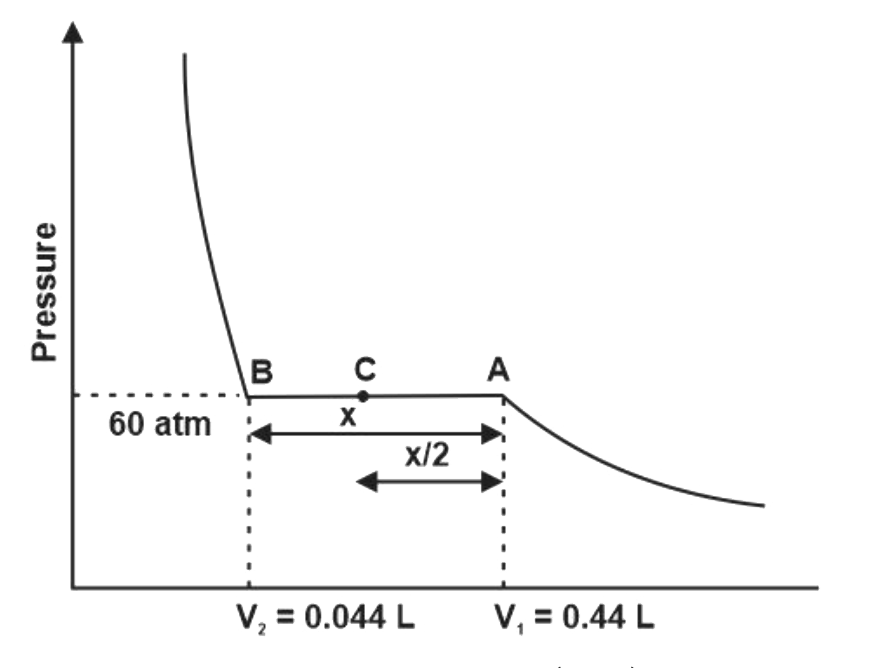Is it possible to liquefy CO2 gas at 50∘ C ? Give a reason.
To determine if it is possible to liquefy carbon dioxide (CO₂) gas at 50°C, we need to consider the concept of critical temperature.
1. Understand the Critical Temperature: The critical temperature of a substance is the highest temperature at which it can exist in the liquid state. For carbon dioxide (CO₂), the critical temperature is approximately 31°C.
2. Compare the Given Temperature with the Critical Temperature: The question states a temperature of 50°C. We need to compare this with the critical temperature of CO₂, which is 31°C.
3. Analyze the Situation: Since 50°C is higher than the critical temperature of 31°C, CO₂ cannot exist in a liquid state at this temperature.
4. Conclusion: Therefore, it is not possible to liquefy CO₂ gas at 50°C because it is above its critical temperature. At temperatures above the critical temperature, the substance will only exist in the gas or vapor phase.
Final Answer:
No, it is not possible to liquefy CO₂ gas at 50°C because this temperature is above the critical temperature of CO₂ (31°C), which means it can only exist as a gas.
---
No, it is not possible to liquefy CO₂ gas at 50°C because this temperature is above the critical temperature of CO₂ (31°C), which means it can only exist as a gas.
Topper's Solved these Questions
- NATURE OF MATTER BOOK - PEARSON IIT JEE FOUNDATIONCHAPTER - NATURE OF MATTER EXERCISE - SHORT ANSWER TYPE QUESTIONS
12 Videos
- NATURE OF MATTER BOOK - PEARSON IIT JEE FOUNDATIONCHAPTER - NATURE OF MATTER EXERCISE - ESSAY TYPE QUESTIONS
4 Videos
- NATURE OF MATTER BOOK - PEARSON IIT JEE FOUNDATIONCHAPTER - NATURE OF MATTER EXERCISE - LEVEL 3
10 Videos
- METALS AND NON-METALSBOOK - PEARSON IIT JEE FOUNDATIONCHAPTER - METALS AND NON-METALSEXERCISE - Level-3 Concept Application
10 Videos
- Organic ChemistryBOOK - PEARSON IIT JEE FOUNDATIONCHAPTER - Organic ChemistryEXERCISE - Level 3
9 Videos
Similar Questions
Knowledge Check
It is possible to liquefy a gas
Aat a temperature above critical temperature and at a pressure above critical pressureBat a temperature at critical temperature and at a pressure lower than critical pressureCat critical temperature and a pressure equal to critical pressureDat a temperature above critical temperature and pressure below critical pressure.The essential conditions for liquefaction of gases were discovered by Andrews in 1869 as a result of his study of pressure-volume-temperature relationship for CO2. If was found that above a certain temperature, it was impossible to liquefy a gas whatever the pressure was applied. The temperature below which the gas can be liquefied by the application of pressure alone is called critical temperature (Tc). The pressure required to liquefy a gas at this temperature is called the critical pressure (Pc). The volume occupied by one mole of the substance at the critical temperature and pressure is called critcal volume. Critical constants are related with van der Waals' constant as follows:
Vc=3b,Pc=a27b2,Tc=8a27Rb
GasesABCDPc(atm)2.2143545Tc(K)5.133127140
Which of the above gases cannot be liquefied at 100 K and 50 atm ?AD onlyBA onlyCA and BDC and DThe essential conditions for liquefaction of gases were discovered by Andrews in 1869 as a result of his study of pressure-volume-temperature relationship for CO2. If was found that above a certain temperature, it was impossible to liquefy a gas whatever the pressure was applied. The temperature below which the gas can be liquefied by the application of pressure alone is called critical temperature (Tc). The pressure required to liquefy a gas at this temperature is called the critical pressure (Pc). The volume occupied by one mole of the substance at the critical temperature and pressure is called critcal volume. Critical constants are related with van der Waals' constant as follows:
Vc=3b,Pc=a27b2,Tc=8a27Rb
Gas A and can be liquefied at room temperature by applying pressure but gas B cannot. This reflects:Acritical temperature of B is less than that of ABcritical temperature of B is greater than that of ACA and B have critical temperature greater than room temperatureDcritical temperature of both are equal
Which is more polar and why, CO2orN2O?
View SolutionOne of the assumptions of kinetic theory of gases states that "there is no force of attraction between the molecules of a gas". How far is this statement correct ? Is it possible to liquefy an ideal gas ? Explain.
View SolutionOne of the assumptions of kinetic theory of gases states that "there is no force of attraction between the molecules of a gas". How far is this statement correct ? Is it possible to liquefy an ideal gas ? Explain.
View SolutionThe essential conditions for liquefaction of gases were discovered by Andrews in 1869 as a result of his study of pressure-volume-temperature relationship for CO2. If was found that above a certain temperature, it was impossible to liquefy a gas whatever the pressure was applied. The temperature below which the gas can be liquefied by the application of pressure alone is called critical temperature (Tc). The pressure required to liquefy a gas at this temperature is called the critical pressure (Pc). The volume occupied by one mole of the substance at the critical temperature and pressure is called critcal volume. Critical constants are related with van der Waals' constant as follows:
Vc=3b,Pc=a27b2,Tc=8a27Rb
The pressure required to liquefy a gas at the critical temperature is called :
View SolutionCO2 gas is liquefaction for 1 mole of CO2.

Then which statement is (are) correct in gaseous phase will
(I) The maximum density of gas is 0.1 gm/ml
(II) The density of liquid CO2 is 1 g/ml at 60 atm.
(III) At point C 50% of CO2 is liquefied.
(IV) The compressibility factor of gas at 27∘C is always less than 1.
Which of the above is/are correct
View Solution